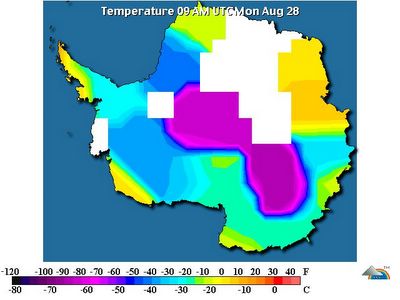
August 28, 2006.
9:00 AM.
Antarctica
There is a 'heat incursion' noted at 6:00 AM. There aren't above zero temperatures registered yet, with the warmest of (-3C) at Palmer Station.
The temperatures across Antarctica (click on)
The temperature at Palmer Station
26 °F / -3 °C
Light Snow
Humidity:
76%
Dew Point:
21 °F / -6 °C
Wind:
9 mph / 14 km/h from the ENE
Wind Gust:
-
Pressure:
29.24 in / 990 hPa (Rising)
Visibility:
3.0 miles / 4.8 kilometers
The higher temperatures won't show up in monitoring stations reported here until they sustain.
Thus far, Antarctica has enjoyed a wonderful retreat of heat for it's ice.
The ice terraces and shelves that have been lost to Human Induced Global Warming takes more than one good season of frigid temperatures to rebuild. It is however 'buying time' on this timeline to biotic demise.
The ice at Antartica is not temperate (Freezing at zero degrees Celcius as do the Juneau Icefields). It is deeply frozen under decades and centuries of hydrostatic pressure. The ice found at the very depths of Lake Vostok is different than the ice found floating in the Ross or Weddel Seas. It has been long known the ice of the seas of Antarctica (WAIS - West Antarctica Ice Sheet - click on), the Greenland Ice and the Arctic Ocean of the northern polar regions are the ice masses that control the climate temperatures of Earth. While the tall 3 mile Blue Ice is valuable to Earth and is a resource to cooling it does not have the immediate impact as the ice resources that touch the oceans. The tall Blue Ice is a fascination all to itself and can be noted in it's 'rock/waterflow' characteristic in the Lambert Ice Flow (click on).
The cross section below may give a better 'idea' of the differences of 'types' of ice of Antarctica.
